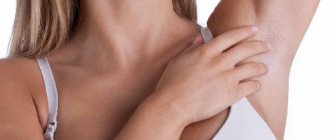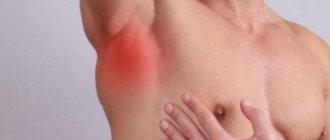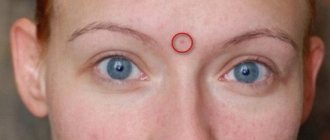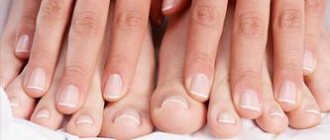A lump under the armpit is a condition for which people often consult a doctor. A kind of “stimulus” for a visit to the doctor is the sensitivity of the armpit and the motor activity of the hands - a combination that does not allow you to endure the discomfort or pain caused by a lump or abscess for a long time. This is a significant plus, which does not allow the patient to wait for this condition to “go away on its own.”
But there is also a minus - there are many reasons why a lump in the armpit can develop.
What does it represent?
The blockage of the sebaceous gland looks like a dense lump that is located under the armpits. At first it is motionless and does not cause pain. It has a regular round shape. It occurs as a result of improper functioning of the sebaceous ducts. They narrow and sebum cannot be removed properly.
At first, blockage of the sebaceous glands does not cause any inconvenience to a person. But if personal hygiene rules are not followed and under the influence of other factors, it can cause a deterioration in the quality of life. The lump enlarges and becomes painful. The situation worsens if the inflammatory process begins to develop.
The blockage is usually treated with surgery. After removal of the sebaceous gland, the patient must undergo a course of antibacterial therapy.
Prevention
To prevent irritation in the armpit area, it is recommended to take preventive measures and maintain personal hygiene, namely:
- Wear clothes made from natural, high-quality fabrics that do not adhere to the skin, do not chafe, and allow moisture to pass through;
- Wipe your armpits daily with warm water and soap, then wipe dry and sprinkle with baby powder (to prevent excessive sweating);
- If you have undergone hair removal with wax, ultrasound, or electric current, do not use deodorant immediately after the procedure;
- Avoid the aggressive look of shaving with blades for a while.
If a skin disease occurs and begins to spread throughout the epidermis, it is necessary to promptly consult a dermatologist for treatment. You can learn about dermatitis in the buttocks area in this article.
Clinical picture
The disease is easy to diagnose. To make a definitive diagnosis, there is no need to carry out a number of additional procedures. An experienced specialist only needs to examine the patient. The following symptoms are distinguished:
- Itching in the affected area. The person notices unpleasant sensations. Patients note itching, the intensity of which may vary. The skin begins to itch more if it gets wet. This occurs when you sweat profusely or after taking a shower or bath.
- The appearance of nodes. Blockage of the sebaceous glands begins with the appearance of nodes. At an early stage of the disease, a small bump appears on the skin. The neoplasm is very dense, so it is very easy to palpate. There is no pain on palpation.
- Pain. With enlargement of the omentum comes pain. This symptom indicates that the disease is progressing. The pain is paroxysmal. Patients report short-term acute pain when changing body position. It becomes difficult for a person to make sudden movements with his hands.
- Increased temperature of the affected areas. In those places where nodes appear, patients note an increase in temperature. It feels like a burning sensation. The skin becomes bright red and an unhealthy oily sheen appears. At the same time, sweating is disrupted, which increases the area of inflammation.
Listed above are the main symptoms that are observed when the sebaceous gland is blocked. But they are not the same in all cases. The clinical picture may vary. Each person's body is individual, so symptoms may manifest differently, depending on the stage of the disease.
Stories from our readers
After 5 years, I finally got rid of the hated papillomas. I haven’t had a single pendant on my body for a month now! I went to doctors for a long time, took tests, removed them with a laser and celandine... but they appeared again and again. I don't know what my body would have looked like if I hadn't come across this article. Anyone who is concerned about papillomas and warts should read this!
Atheroma can appear on any part of the body where hair grows, but its predominant localization is on the scalp, face (especially below the mouth), back, neck, genital area. Often we notice a small thickening on the skin. It is painless when pressed; the color of the skin in this area is no different from the general skin. Many people simply call it wen. This formation does not bring us much discomfort, and we do not pay attention to this trouble, hoping that in a couple of days everything will go away by itself. But it's still worth worrying about. This is atheroma. And this is a benign, but still a tumor.
How to get rid of the disease?
Treatment of the disease begins with taking medications. If no positive results are observed during therapy, it turns out to be ineffective. This indicates that the disease is at the last stage. In this case, surgical treatment is used.
Treatment with surgery is usually very quick. The inflamed abscess is opened. Its contents are completely removed. After surgical manipulations, a number of procedures are carried out, the purpose of which is to promote the healing of damaged tissue.
The patient is prohibited from opening the tumors on his own. He does not know all the intricacies of the procedure. In this case, there is a possibility of infection and further spread of the disease. The operation is performed only by a doctor using sterile instruments.
Recipes for treating atheroma with folk remedies
This method of treatment is the most widely used. After all, sometimes you should trust the centuries-old experience of mankind, which also has good results. In addition, the recipes use natural ingredients that cause less harm, and more often only benefit, to the body as a whole. Since atheroma is a tumor, traditional medicine suggests using plants with anti-inflammatory, absorbable and disinfectant properties.
Such as:
Often, folk remedies also use other components that are afraid of any inflammation: honey and lamb fat.
Complications
Refusal of treatment may result in the development of complications. A blocked sweat gland develops into inflammation under the armpit, which is called hidradenitis. It causes a lot of inconvenience to the patient. It is customary to distinguish several forms of hidradenitis:
- acute purulent;
- nodal;
- chronic.
Acute hidradenitis
The cause of the development of pathology is blockage of the sweat and sebaceous glands. The disease threatens those people who do not take good care of their armpits. Due to the fact that the omentum is inflamed, the patient experiences typical symptoms. The patient complains of discomfort and malaise, which gradually develops into painful sensations in the armpits.
Body temperature rises. As a rule, it remains low-grade, but may increase. The acute form of hidradenitis is considered life-threatening and it is necessary to seek medical help.
Nodal form
The skin in the armpit area is delicate, so it can be easily injured. Sloppy shaving leaves behind cuts. Microorganisms enter the wounds that have formed, forming pathogenic microflora. As a result, nodules are formed. If they are not treated in time, the inflammatory disease develops into a purulent form.
Chronic or recurrent hidradenitis
This form of the disease is characterized by the formation of purulent wounds that do not go away for a long time. Hidradenitis periodically manifests itself in an acute phase. At times the pain subsides and the person feels better. The inflammatory process affects a large number of apocrine glands. If you do not get rid of the purulent process, the patient’s life will be at risk.
Treatment of atheroma
Atheroma only rarely develops into a cancerous tumor, but, like any disease, it requires treatment. After all, this is not just an unsightly cosmetic defect, but also an inflammatory process in the body. Over time, it can grow, sometimes it becomes infected, and then, in addition to pain and inconvenience, there is a danger of sepsis, since the contents of the atheroma, when mechanically damaged, enter the blood of nearby tissues and are quickly distributed to different organs.
Carefully dissect the skin, trying not to damage the atheroma capsule. The skin is moved away from the atheroma, after which, pressing with fingers on the edges of the wound, the atheroma is peeled off
There are few ways to remove atheroma from your body forever, this is:
- Surgical intervention;
- Laser removal;
- Combined (surgical combined with laser treatment);
- Non-surgical: using medications at home or folk remedies.
The best way to get rid of a cyst is surgery. The operation to remove atheroma is simple. It is performed on an outpatient basis under local anesthesia.
conclusions
Clogging of the sweat and sebaceous glands is not a pleasant phenomenon. If not properly treated, it can cause the development of hidradenitis. It is considered one of the most dangerous among similar diseases, since purulent neoplasms appear on the skin.
At the first manifestation of blockage symptoms, it is recommended to immediately seek medical help. Under no circumstances should you self-medicate.
It is better to prevent any disease than to treat it later. The same applies to hidradenitis. To ensure that the sebaceous and sweat glands are never clogged, it is necessary to carefully monitor personal hygiene. But you shouldn’t overuse cosmetics. If you listen to these simple rules, you can maintain excellent health.
Atheromatosis
When a large number of small cysts appear, this phenomenon is called multiple atheromatosis.
A characteristic feature of the disease is the accumulation of lipids on the walls of blood vessels. Gradually, the lumen narrows, the outflow of blood is disrupted, and in this state coronary disease can occur. Plaques can transform into a blood clot, which when broken off causes blockage of the vessel. The localization of atheromatosis formations is mainly located on the head, armpits, and groin area.
External reasons
Red formations appear not only as a result of diseases, but also under the influence of exogenous factors:
- shaving, not performing according to the rules. For example: shaving dry skin without using cream or foam, shaving hair against its growth with a machine;
- shaving 2-3 times a day;
- wearing synthetics after shaving armpit hair;
- poor hygiene – infrequent showering accompanied by heavy sweating (this is often observed in men and women who are prone to obesity);
- skin irritation due to different types of depilation: sugaring, waxing, use of depilatory creams.
Sometimes antiperspirants become the culprits of red spots. This can happen for several reasons:
- the product is applied to dirty skin;
- the deodorant is aggressive, and the skin is hypersensitive. In this case, you need to select hypoallergenic antiperspirants;
- It is necessary to spray while keeping the bottle away from the skin (at least five centimeters). Otherwise, the deodorant may burn your skin. Then the red spot under the armpit hurts and is very disturbing.
Methods of therapy
Medications
If the blockage of the gland has not yet brought serious complications and the disease is diagnosed in a timely manner, medications will help the formation resolve, thanks to which it will be possible to stop the inflammation and alleviate the accompanying symptoms. Appointed:
- Antibiotics - Erythromycin, Tetracycline. Medicines from the macrolide group that help block the proliferation of the pathogen.
- Anti-inflammatory - Triamcinolone.
- Antipyretics - Paracetamol, Ibuprofen.
If the pathology occurs in an acute form, then the treatment regimen is as follows:
- An injection of lidocaine and Triamcinolone is injected into the painful node.
- After the injection, the growth is opened and washed, which will prevent frequent relapses.
In the presence of a purulent cavity, surgical intervention is indicated.
In advanced stages, a bandage is applied to the area where hidradenitis is localized, the basis of which is ichthyol ointment and Levomekol, which help relieve unpleasant symptoms. Treatment is also provided:
- antibacterial based on Azithromycin, Tetracycline, Minocycline;
- anti-inflammatory drugs such as Prednisolone.
To speed up recovery, local treatment is recommended, in which a bandage soaked in bactericidal soap, 5% tincture of iodine and 2% boric alcohol is applied to the site of inflammation. Anti-inflammatory ointments are also effective:
- "Erythromycin";
- "Levomekol";
- "Neomycin";
- Ichthyol.
Folk remedies
It is not recommended to treat the pathology yourself at home. Therefore, if you have characteristic symptoms, it is first recommended to visit a dermatologist. If he doesn’t mind, then you can use folk remedies as an auxiliary therapy. The following recipes have worked well:
- Dressing using sour cream and flour. To prepare, take 2 tbsp. l. fermented milk product and 1 large spoon of flour. Combine the ingredients, place on a clean cloth and apply to the problem area overnight. Thanks to this dressing, it will be possible to unblock the sweat gland and eliminate inflammation.
- A compress based on cabbage leaves. Mash a freshly picked cabbage leaf a little and apply it to the sore spot overnight. The inflammation will decrease and the symptoms will go away.
Physiotherapy treatment
Physiotherapeutic treatment is not indicated in the suppuration phase.
This method of auxiliary treatment is also often prescribed to speed up recovery. Applicable:
- phytochemotherapy;
- magnetic laser therapy;
- quartz;
- electrophoresis.
X-ray therapy for hidradenitis is used only when the disease often recurs. Thanks to X-rays, the sweat glands are completely destroyed, as a result of which the root cause of the development of pathology is eliminated. However, this method is used in extreme cases when other methods, including surgical ones, have failed.
Radical methods
When a purulent growth becomes inflamed, the neoplasm is opened, cleaned and drained. If this does not help, complete removal of hidradenitis and infected surrounding tissues is carried out, after which antibacterial therapy is prescribed. Surgery in combination with drug therapy will make it possible to prevent relapses.











